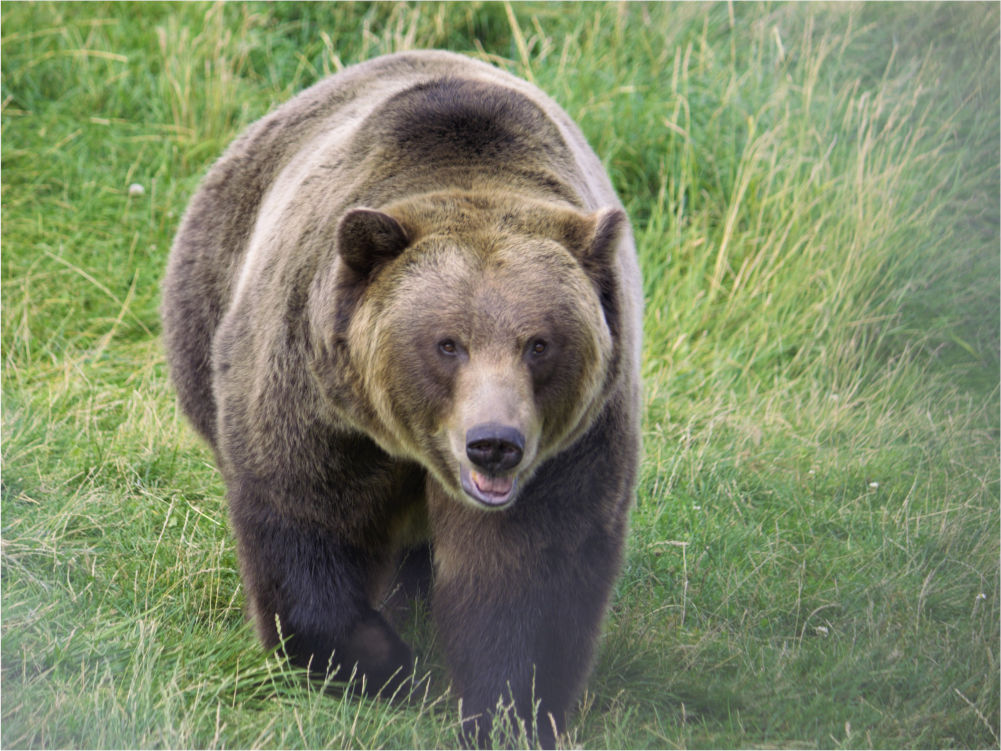
The largest carnivores of the Wild Clearwater, grizzly bears (also called the North American brown bear) were listed as a threatened species under the Endangered Species Act (ESA) in 1975.
Conservation status: Threatened
There are few animals more wondrous than the grizzly bear (Ursus arctos horribilis). Both physically large and intelligent, it is no surprise many call this omnivore the "Great Bear". Grizzly bears are ingrained into the fabric of the American West, in Indigenous stories, folk tales, and even the Californian flag.
Beginning in the 1800s, tens of thousands of grizzly bears (some 98% of the population in the lower 48 States) were shot, trapped, or poisoned to near extinction. In 1946, US Forest Service ranger Bud Moore saw one of the last signs of grizzly bears in the Clearwater—one dry footprint.
In 1975, grizzly bears were listed as a threatened species, surviving only in Glacier and Yellowstone National Parks, the Idaho Panhandle, and perhaps other remote areas.
In the 50 years since, populations have grown slowly and grizzly bears have expanded their ranges. Unfortunately, efforts to remove federal protections are frequent, developments in the wildland-urban-interface are accelerating, and grizzly mortality remains extremely high, almost entirely due to human pressures.
Central Idaho has the best unoccupied grizzly bear habitat in the lower 48 states, what one Montana researcher calls the "grizzly bear promised land". Since 2007, when a grizzly was illegally killed near Kelly Creek, several presumably male grizzly bears have been documented in Clearwater Country, but as of 2025 no known breeding population exists in north-central Idaho.
As of 2025, grizzly bears remain threatened and the US Fish and Wildlife Service is analyzing how to recover grizzly bears in the Bitterroot Ecosystem.
Description: Equipped with massive shoulders and muscular necks, females weigh between 300 – 450 lbs., with males averaging 400 – 800 lbs. Largest males can weigh over 1,000 lbs. Shoulder height is approximately 36 inches; body length is 72 – 96 inches. Run up to 35 mph and have long, non-retractable claws for digging. Brown – yellow – cinnamon fur with distinguishable back or shoulder hump (black bears do not have hump).
Diet: Largely omnivores, 70 – 80% of diet is vegetation, including roots, stems, leaves, flowers, nuts and berries. Adept at digging up insects, squirrel caches, marmot dens and mice. Also prey on larger mammals, particularly young elk, deer and moose. White-bark pine nuts historically invaluable source of nutrition; has severely declined in the Clearwater for several decades due to fungal disease and is declining in drier parts of the Rockies due to climate change. Other traditional food losses (salmon, steelhead trout, huckleberries) are also in decline.
Habitat: Once prominent along short-grass prairie of West; now largely limited to ridges, mountains, and forested landscapes of Northern Rockies. Require large tracts of protected landscapes with minimal road density and human disturbance. Denning usually begins October/November and hibernates throughout winter. During hibernation, grizzlies do not eat or drink, and very rarely urinate or defecate.
Range: Five designated recovery zones: Greater-Yellowstone, Northern Continental Divide, Cabinet-Yaak, Selkirk, and Bitterroot; latter includes portions of the Clearwater Basin. These recovery zones are geographically isolated—a major hurdle for true recovery. Long-term survival of grizzly bears in the United States requires connected habitat, for example between Yellowstone and the Bitterroot Ecosystem through the Centennial range. These corridors need to be included in designated recovery areas.
Reproduction: Produce cubs every other year or every three years; do not breed until 5-7 years of age. Typically mate June/July, but embryos do not implant until October/November if sow has adequate fat stores. Sows give birth (typically one or two, rarely as many as four) cubs in January. Cubs emerge from den in April/May with mother.
Threats: Road building, logging, habitat loss/fragmentation, poaching, and loss of high quality foods. Lack of connectivity (bears moving/breeding with bears in other recovery zones) is also a major threat.
Legal Status: Remain listed as threatened under Endangered Species Act despite wrongful attempts of federal government to remove from Endangered Species List.
Local Sightings: In 2007, a 500 – 600lb. male grizzly bear shot/killed in Kelly Creek drainage on Clearwater National Forest by client of local outfitter. DNA results indicate bear dispersed from Selkirk Mountains in North Idaho, the first confirmed grizzly bear in North Central Idaho in approximately sixty years.
In 2018, male grizzly appeared in Bitterroot Valley of Montana but was relocated north of I-90.
In 2019, at least two grizzly bears were confirmed in central Idaho, including near White Bird and Newsome Creek on the Nez Perce National Forest and near Lolo Pass on the Clearwater National Forest.
In April of 2020, grizzly tracks were confirmed just south of Grangeville, the first evidence of year-round grizzly presence in the Clearwater in decades.
In 2022, two grizzlies frequented the Bitterroot valley between Lolo and Florence, just east of the Selway-Bitterroot Wilderness. The Montana Dept. of Fish, Wildlife, and Parks captured the bears and released them in the Sapphire Mountains. The bears had "not yet been in conflict with people".
In 2024, a young male grizzly was shot at a black bear bait station near St. Maries, Idaho in the St. Joe watershed. According to news reports, the hunter had sent in video footage to the Idaho Department of Fish and Game to help identify the bear, since he was not sure if it was a cinnamon-colored black bear or a young grizzly. After shooting the bear, and discovering it was actually a grizzly, the hunter reported the incident to Idaho Fish and Game. Shockingly, an employee said via email "we don’t need griz in the Joe." This is further evidence that state-management of grizzly bears would be a serious loss to protection of the species.
In 2025, the IDFG updated black bear hunting rules to require completing an identification quiz online to distinguish grizzly and black bears.
Friends of the Clearwater
PO Box 9241
Moscow, ID 83843
(208) 882-9755